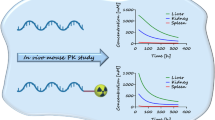Summary
Antisense oligonucleotides are promising therapeutic agents for the treatment of life-threatening diseases.
Intravenous injection of phosphodiester oligonucleotide analogue (P-oligonucleotide) in monkeys shows that the oligonucleotide is degraded rapidly in the plasma with a half-life of about 5 minutes. Administration of a single dose of the phosphorothioate (S-oligonucleotide) in animals by the intravenous route reveals biphasic plasma elimination. An initial short half-life (0.53 to 0.83 hours) represents distribution out of the plasma compartment and a second long half-life (35 to 50 hours) represents elimination from the body. This elimination half-life was similar when the oligonucleotide was administered subcutaneously. In contrast, methylphosphonate oligonucleotides have an elimination half-life of 17 minutes in mice.
S-Oligonucleotide was distributed into most of organs of rats and mice. Liver and kidney were the 2 organs with highest uptake of the oligonucleotide. The S-oligonucleotide was primarily excreted in urine. Up to 30% was excreted in the first 24 hours.
Repeated daily intravenous injections of a 25-mer S-oligonucleotide into rats showed that the concentrations in the plasma are at steady-state during the 8 days’ administration.
The data represented here support the potential utility of phosphorothioate and methylphosphonate oligonucleotides as therapeutic agents in vivo.
Similar content being viewed by others
References
Zamecnik PC. Oligonucleotide base hybridization as a modulator of genetic message readout. In: Wickstrom E, editor. Prospects for antisense nucleic acid therapy of cancer and AIDS. New York: Wiley-Liss, 1991: 1–5
Wickstrom E, editor. Prospects for antisense nucleic acid therapy of cancer and AIDS. New York: Wiley-Liss, 1991
Murray JAH, editor. Antisense RNA and DNA. New York: Wiley-Liss, 1992
Crooke ST, Lebleu B, editors. Antisense research and applications. Boca Raton: CRC Press, 1993
Baserga R, Denhart DT. Antisense strategies. Ann NY Acad Sci 1992; 660
Mol JNM, van der Krol AR, editors. Antisense nucleic acids and proteins: fundamentals and applications. New York: Marcel Dekker, 1991
Stec WJ, Zon G, Egan W, et al. Automated solid-phase synthesis, separation and stereochemistry of phosphorothioate analogues of oligodeoxynucleotides. J Am Chem Soc 1984; 106: 6077–9
Agrawal S. Antisense oligonucleotides as antiviral agents, Trends Biotechnol Sci 1992; 10: 152–7
Miller PS, Ts’O POP. Oligonucleotide inhibitors of gene expression in living cells: new opportunities in drug design. Ann Med Chem 1988; 23: 295
Agrawal S. Antisense oligonucleotides: a possible approach for chemotherapy of AIDS. In: Wickstrom E, editor. Prospects for antisense nucleic acid therapy of cancer and AIDS. New York: Wiley-Liss, 1991: 143–58
Agrawal S, editor. Protocols for oligonucleotides and analogs: synthesis and properties. Totowa, New Jersey: Human Press, 1993
Agrawal S, Temsamani J, Tang J-Y. Pharmacokinetics bio-distribution, and stability of oligodeoxynucleotide phosphorothioates in mice. Proc Natl Acad Sci USA 1991; 88: 7595–9
Agrawal S, Ikeuchi T, Sun D, et al. Inhibition of human immunodeficiency virus in early infected and chronically infected cells by antisense oligodeoxynucleotides and their phosphorothioate analogues. Proc Natl Acad Sci USA 1989; 86: 7790–4
Agrawal S, Tang J-Y. GEM 91 — an antisense oligonucleotide phosphorothioate as a therapeutic agent for AIDS. Antisense Res Dev 1992; 2: 261–6
Sands H, Gorey-Feret LJ, Cocuzza AJ, et al. Biodistribution and metabolism of internally 3H-labelled oligonucleotides. I. Comparison of a phosphodiester and a phosphorothioate. Mol Pharmacol 1994; 45: 932–943
Chem TL, Miller P, Ts’O P, et al. Disposition and metabolism of oligodeoxynucleoside methylphosphonate following a single iv injection in mice. Drug Metab Dispos 1990; 18: 815–8
Wagner JG. Fundamentals of clinical pharmacokinetics. Hamilton, Illinois: Drug Intelligence Publications, 1979
Zhang G, Yan T, Shahinian H, et al. Human pharmacokinetics of an anti-HIV antisense oligodeoxynucleotide phosphorothioate (GEM 91) in HIV-1 infected individuals [abstract]. Presented at the 34th Interscience Conference on Antimicrobial Chemotherapy, (ICAAC); 1994 Oct 4–7: Orlando (FL), 6, A5.
Bayever E, Iversen PL, Bishop MR, et al. Systematic administration of a phosphorothioate oligonucleotide with a sequence complementary to p53 for acute myelogenous leukaemia and myelodysplastic syndrome: initial results of a phase I trial. Antisense Res Dev 1993, 3: 383–90
Inagaki M, Togawa K, Carr BI, et al. Antisense oligonucleotides: inhibition of liver cell proliferation and in vivo disposition. Transplant Proc 1992; 26: 2971–2
Cossum PA, Sasmor H, Dellinger D, et al. Disposition of the 14C-labeled phosphorothioate oligonucleotide ISIS 2105 after intravenous administration to rats. J Pharmacol Exp Ther 1993; 267: 1181–90
Iversen P. In vivo studies with phosphorothioate oligonucleotides: rationale for systemic therapy. In: Crooke ST, Lebleu B, editors. Antisense research and applications. Boca Raton: CRC Press, 1993: 461–9
Iversen PL, Mata J, Tracewell WG, et al. Pharmacokinetics of an antisense phosphorothioate oligodeoxynucleotide against rev from human immunodeficiency virus type 1 in the adult male rat following single injections and continuous infusion. Antisense Res Dev 1994; 4: 43–52
Temsamani J, Tang J-Y, Padmapriya AA, et al. Pharmacokinetics, biodistribution and stability of capped oligodeoxynucleotide phosphorothioates in mice. Antisense Res Dev 1993; 3: 277–84
Zendegui J, Vasquez K, Tinsley J, et al. In vivo stability and kinetics of absorption and disposition of 3′ phosphopropyl amine oligonucleotides. Nucleic Acids Res 1992; 20: 307–14
Temsamani J, Kubert M, Agrawal S. A rapid method for quantitation of oligonucleotide phosphorothiates in biological fluids and tissues. Anal Biochem 1993; 215: 54–8
Zamencnik PC, Stephenson ML. Inhibition of Rous Sarcoma virus replication and cell transformation by a specific oligonucleotide. Proc Natl Acad Sci USA 1978; 75: 280–4
Author information
Authors and Affiliations
Rights and permissions
About this article
Cite this article
Agrawal, S., Temsamani, J., Galbraith, W. et al. Pharmacokinetics of Antisense Oligonucleotides. Clin. Pharmacokinet. 28, 7–16 (1995). https://doi.org/10.2165/00003088-199528010-00002
Published:
Issue Date:
DOI: https://doi.org/10.2165/00003088-199528010-00002




